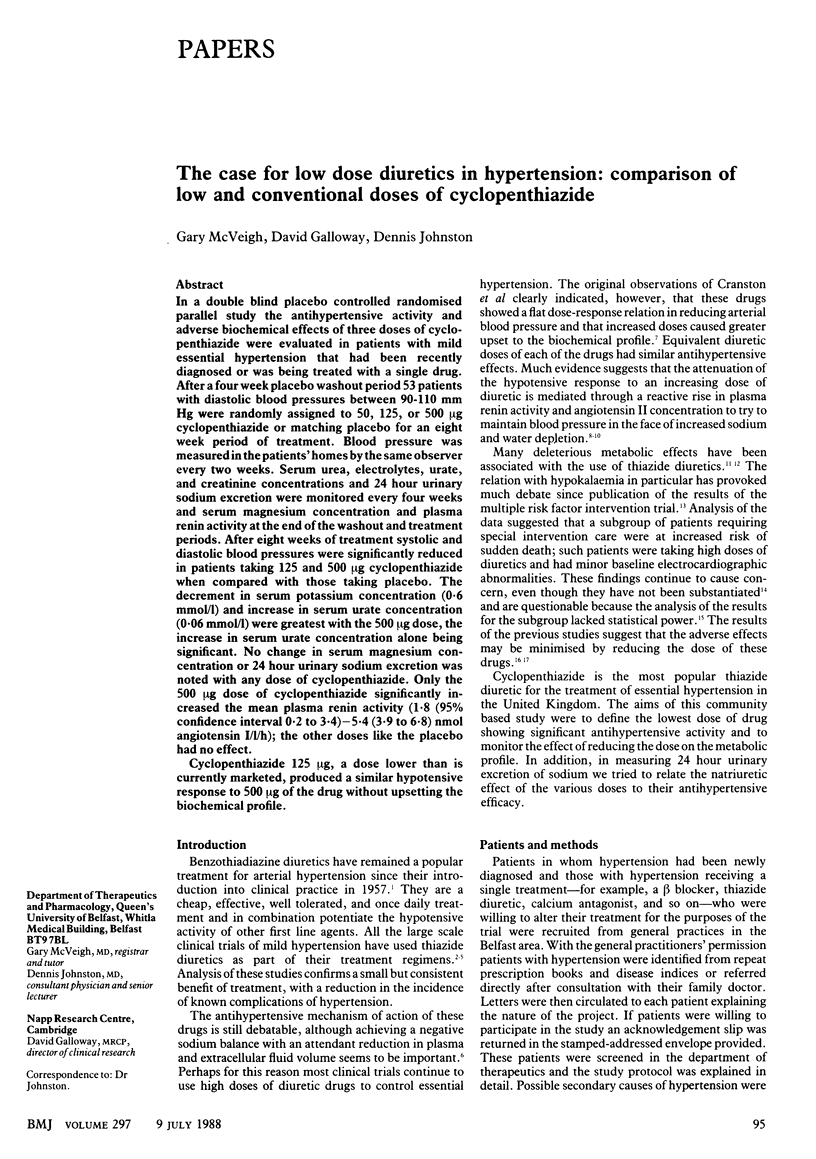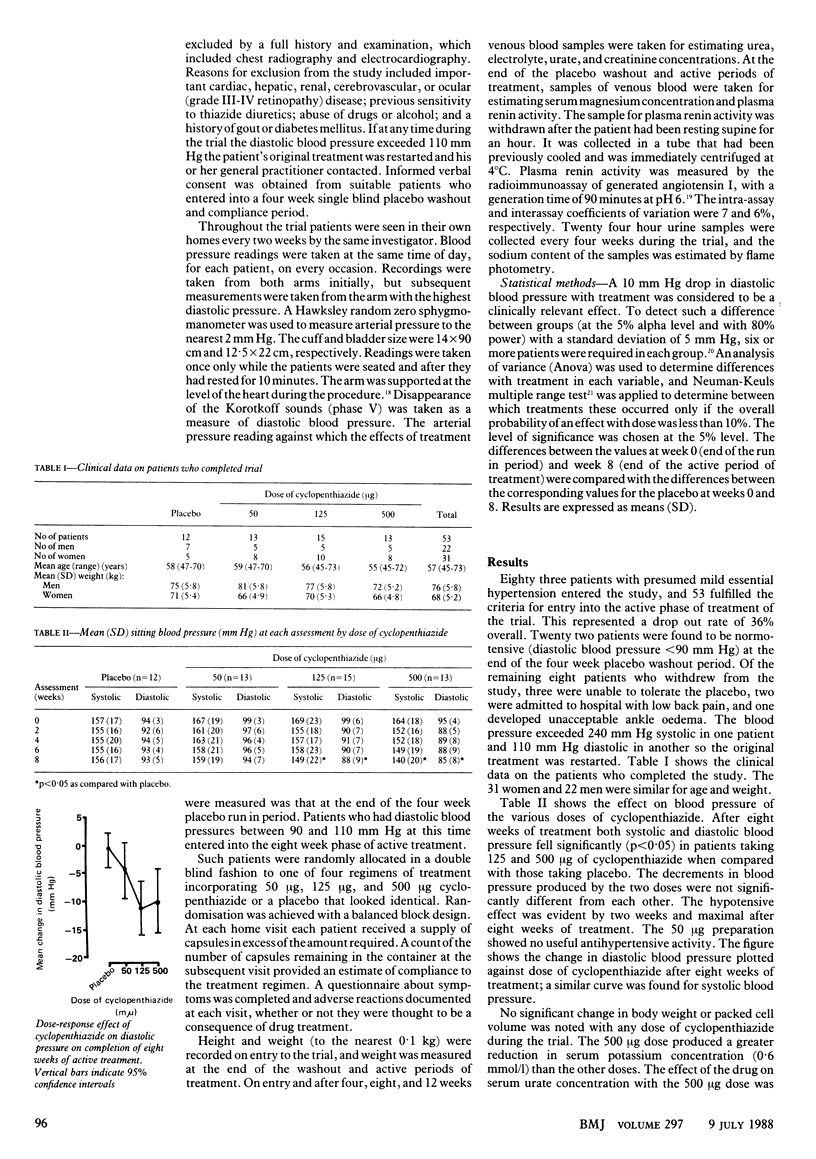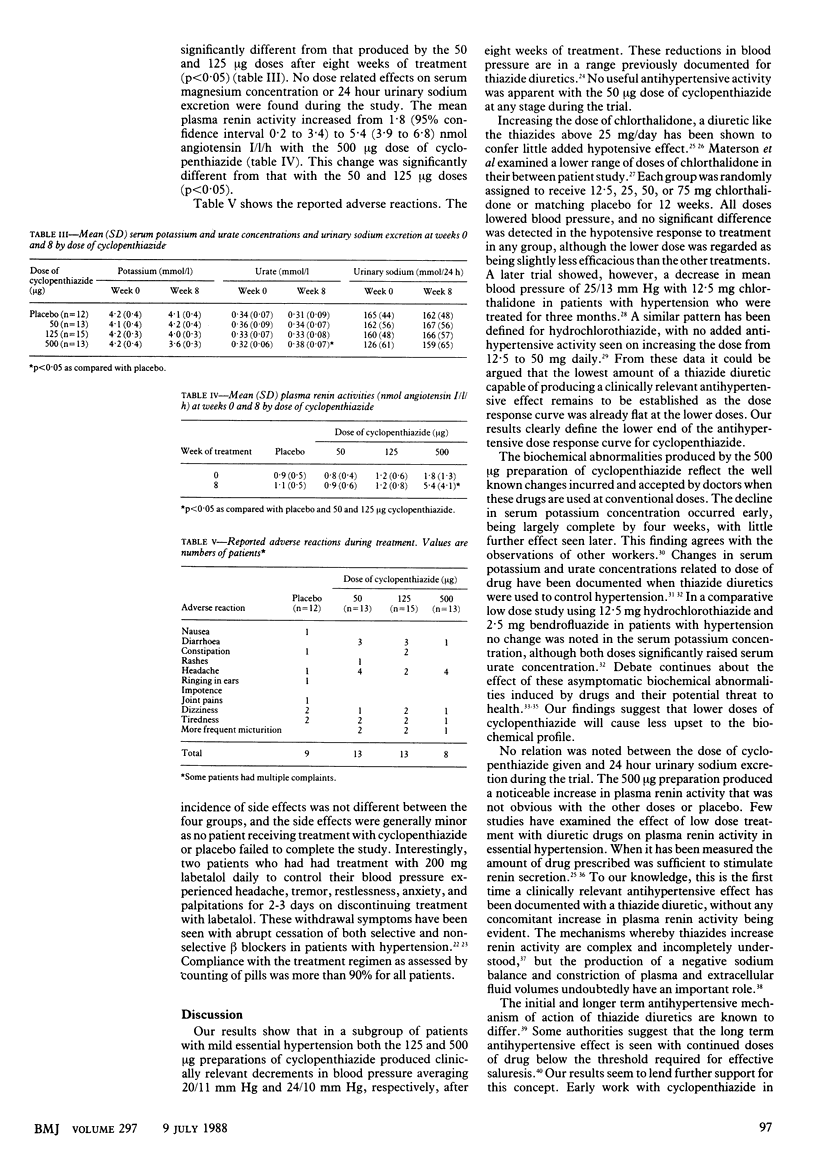Abstract
In a double blind placebo controlled randomised parallel study the antihypertensive activity and adverse biochemical effects of three doses of cyclopenthiazide were evaluated in patients with mild essential hypertension that had been recently diagnosed or was being treated with a single drug. After a four week placebo washout period 53 patients with diastolic blood pressures between 90-110 mm Hg were randomly assigned to 50, 125, or 500 micrograms cyclopenthiazide or matching placebo for an eight week period of treatment. Blood pressure was measured in the patients' homes by the same observer every two weeks. Serum urea, electrolytes, urate, and creatinine concentrations and 24 hour urinary sodium excretion were monitored every four weeks and serum magnesium concentration and plasma renin activity at the end of the washout and treatment periods. After eight weeks of treatment systolic and diastolic blood pressures were significantly reduced in patients taking 125 and 500 micrograms cyclopenthiazide when compared with those taking placebo. The decrement in serum potassium concentration (0.6 mmol/l) and increase in serum urate concentration 0.06 mmol/l) were greatest with the 500 micrograms dose, the increase in serum urate concentration alone being significant. No change in serum magnesium concentration or 24 hour urinary sodium excretion was noted with any dose of cyclopenthiazide. Only the 500 micrograms dose of cyclopenthiazide significantly increased the mean plasma renin activity (1.8 (95% confidence interval 0.2 to 3.4)-5.4 (3.9 to 6.8) nmol angiotensin I/l/h); the other doses like the placebo had no effect. Cyclopenthiazide 125 micrograms, a dose lower than is currently marketed, produced a similar hypotensive response to 500 micrograms of the drug without upsetting the biochemical profile.
Full text
PDF



Selected References
These references are in PubMed. This may not be the complete list of references from this article.
- Bengtsson C., Johnsson G., Sannerstedt R., Werkö L. Effect of different doses of chlorthalidone on blood pressure, serum potassium, and serum urate. Br Med J. 1975 Jan 25;1(5951):197–199. doi: 10.1136/bmj.1.5951.197. [DOI] [PMC free article] [PubMed] [Google Scholar]
- Boyd J. C., Bruns D. E., DiMarco J. P., Sugg N. K., Wills M. R. Relationship of potassium and magnesium concentrations in serum to cardiac arrhythmias. Clin Chem. 1984 May;30(5):754–757. [PubMed] [Google Scholar]
- CRANSTON W. I., JUEL-JENSEN B. E., SEMMENCE A. M., JONES R. P., FORBES J. A., MUTCH L. M. EFFECTS OF ORAL DIURETICS ON RAISED ARTERIAL PRESSURE. Lancet. 1963 Nov 9;2(7315):966–970. doi: 10.1016/s0140-6736(63)90671-8. [DOI] [PubMed] [Google Scholar]
- Carney S., Gillies A. I., Morgan T. Optimal dose of a thiazide diuretic. Med J Aust. 1976 Oct 30;2(18):692–693. doi: 10.5694/j.1326-5377.1976.tb130430.x. [DOI] [PubMed] [Google Scholar]
- Degnbol B., Dorph S., Marner T. The effect of different diuretics on elevated blood pressure and serum potassium. Acta Med Scand. 1973 May;193(5):407–410. doi: 10.1111/j.0954-6820.1973.tb10601.x. [DOI] [PubMed] [Google Scholar]
- Guthrie G. P., Jr, Genest J., Kuchel O. Renin and the therapy of hypertension. Annu Rev Pharmacol Toxicol. 1976;16:287–308. doi: 10.1146/annurev.pa.16.040176.001443. [DOI] [PubMed] [Google Scholar]
- HOLLANDER W., WILKINS R. W. Chlorothiazide: a new type of drug for the treatment of arterial hypertension. BMQ. 1957 Sep;8(3):69–75. [PubMed] [Google Scholar]
- Haber E., Koerner T., Page L. B., Kliman B., Purnode A. Application of a radioimmunoassay for angiotensin I to the physiologic measurements of plasma renin activity in normal human subjects. J Clin Endocrinol Metab. 1969 Oct;29(10):1349–1355. doi: 10.1210/jcem-29-10-1349. [DOI] [PubMed] [Google Scholar]
- Helgeland A. Treatment of mild hypertension: a five year controlled drug trial. The Oslo study. Am J Med. 1980 Nov;69(5):725–732. doi: 10.1016/0002-9343(80)90438-6. [DOI] [PubMed] [Google Scholar]
- Hollifield J. W. Thiazide treatment of hypertension. Effects of thiazide diuretics on serum potassium, magnesium, and ventricular ectopy. Am J Med. 1986 Apr 25;80(4A):8–12. doi: 10.1016/0002-9343(86)90335-9. [DOI] [PubMed] [Google Scholar]
- Ibrahim M. M., Tarazi R. C., Dustan H. P., Gifford R. W., Jr Electrocardiogram in evaluation of resistance to antihypertensive therapy. Arch Intern Med. 1977 Sep;137(9):1125–1129. [PubMed] [Google Scholar]
- Kleinert H. D., Harshfield G. A., Pickering T. G., Devereux R. B., Sullivan P. A., Marion R. M., Mallory W. K., Laragh J. H. What is the value of home blood pressure measurement in patients with mild hypertension? Hypertension. 1984 Jul-Aug;6(4):574–578. doi: 10.1161/01.hyp.6.4.574. [DOI] [PubMed] [Google Scholar]
- Knochel J. P. Diuretic-induced hypokalemia. Am J Med. 1984 Nov 5;77(5A):18–27. doi: 10.1016/s0002-9343(84)80004-2. [DOI] [PubMed] [Google Scholar]
- Lammintausta R., Lammintausta K. The renin-aldosterone system in low-dose chlorothiazide treatment of hypertensive subjects. Int J Clin Pharmacol Ther Toxicol. 1980;18(8):329–331. [PubMed] [Google Scholar]
- Materson B. J., Oster J. R., Michael U. F., Bolton S. M., Burton Z. C., Stambaugh J. E., Morledge J. Dose response to chlorthalidone in patients with mild hypertension. Efficacy of a lower dose. Clin Pharmacol Ther. 1978 Aug;24(2):192–198. doi: 10.1002/cpt1978242192. [DOI] [PubMed] [Google Scholar]
- Morgan D. B., Davidson C. Hypokalaemia and diuretics: an analysis of publications. Br Med J. 1980 Mar 29;280(6218):905–908. doi: 10.1136/bmj.280.6218.905. [DOI] [PMC free article] [PubMed] [Google Scholar]
- Moser M. Clinical trials, diuretics, and the management of mild hypertension. Arch Intern Med. 1984 Apr;144(4):789–793. [PubMed] [Google Scholar]
- Papademetriou V., Fletcher R., Khatri I. M., Freis E. D. Diuretic-induced hypokalemia in uncomplicated systemic hypertension: effect of plasma potassium correction on cardiac arrhythmias. Am J Cardiol. 1983 Nov 1;52(8):1017–1022. doi: 10.1016/0002-9149(83)90523-4. [DOI] [PubMed] [Google Scholar]
- Pedersen O. L. Comparison of metoprolol as hydrochlorothiazide and antihypertensive agents. Eur J Clin Pharmacol. 1976;10(6):381–385. doi: 10.1007/BF00563073. [DOI] [PubMed] [Google Scholar]
- Ram C. V. Diuretics in the management of hypertension. Postgrad Med. 1982 Feb;71(2):155-9, 162-8. doi: 10.1080/00325481.1982.11715994. [DOI] [PubMed] [Google Scholar]
- Rangno R. E., Langlois S. Comparison of withdrawal phenomena after propranolol, metoprolol, and pindolol. Am Heart J. 1982 Aug;104(2 Pt 2):473–478. doi: 10.1016/0002-8703(82)90142-9. [DOI] [PubMed] [Google Scholar]
- Russell J. G., Mayhew S. R., Humphries I. S. Chlorthalidone in mild hypertension - dose response relationship. Eur J Clin Pharmacol. 1981;20(6):407–411. doi: 10.1007/BF00542091. [DOI] [PubMed] [Google Scholar]
- Schmidt G. R., Pitterle M. E., Schuna A. A. Home blood pressure readings in clinical hypertension research. Clin Pharm. 1986 Nov;5(11):917–920. [PubMed] [Google Scholar]
- Shah S., Khatri I., Freis E. D. Mechanism of antihypertensive effect of thiazide diuretics. Am Heart J. 1978 May;95(5):611–618. doi: 10.1016/0002-8703(78)90303-4. [DOI] [PubMed] [Google Scholar]
- Smith W. E., Steele T. H. Avoiding diuretic-related complications in older patients. Geriatrics. 1983 Feb;38(2):117-9, 124. [PubMed] [Google Scholar]
- Sokolow M., Werdegar D., Kain H. K., Hinman A. T. Relationship between level of blood pressure measured casually and by portable recorders and severity of complications in essential hypertension. Circulation. 1966 Aug;34(2):279–298. doi: 10.1161/01.cir.34.2.279. [DOI] [PubMed] [Google Scholar]
- Tweeddale M. G., Ogilvie R. I., Ruedy J. Antihypertensive and biochemical effects of chlorthalidone. Clin Pharmacol Ther. 1977 Nov;22(5 Pt 1):519–527. doi: 10.1002/cpt1977225part1519. [DOI] [PubMed] [Google Scholar]
- Vaughan E. D., Jr, Carey R. M., Peach M. J., Ackerly J. A., Ayers C. R. The renin response to diuretic therapyl A limitation of antihypertensive potential. Circ Res. 1978 Mar;42(3):376–381. doi: 10.1161/01.res.42.3.376. [DOI] [PubMed] [Google Scholar]
- Weber M. A., Lopez-Ovejero J. A., Drayer J. I., Case D. B., Laragh J. H. Renin reactivity as a determinant of responsiveness to antihypertensive treatment. Arch Intern Med. 1977 Mar;137(3):284–289. [PubMed] [Google Scholar]
- Webster J., Newnham D., Petrie J. C., Lovell H. G. Influence of arm position on measurement of blood pressure. Br Med J (Clin Res Ed) 1984 May 26;288(6430):1574–1575. doi: 10.1136/bmj.288.6430.1574. [DOI] [PMC free article] [PubMed] [Google Scholar]


